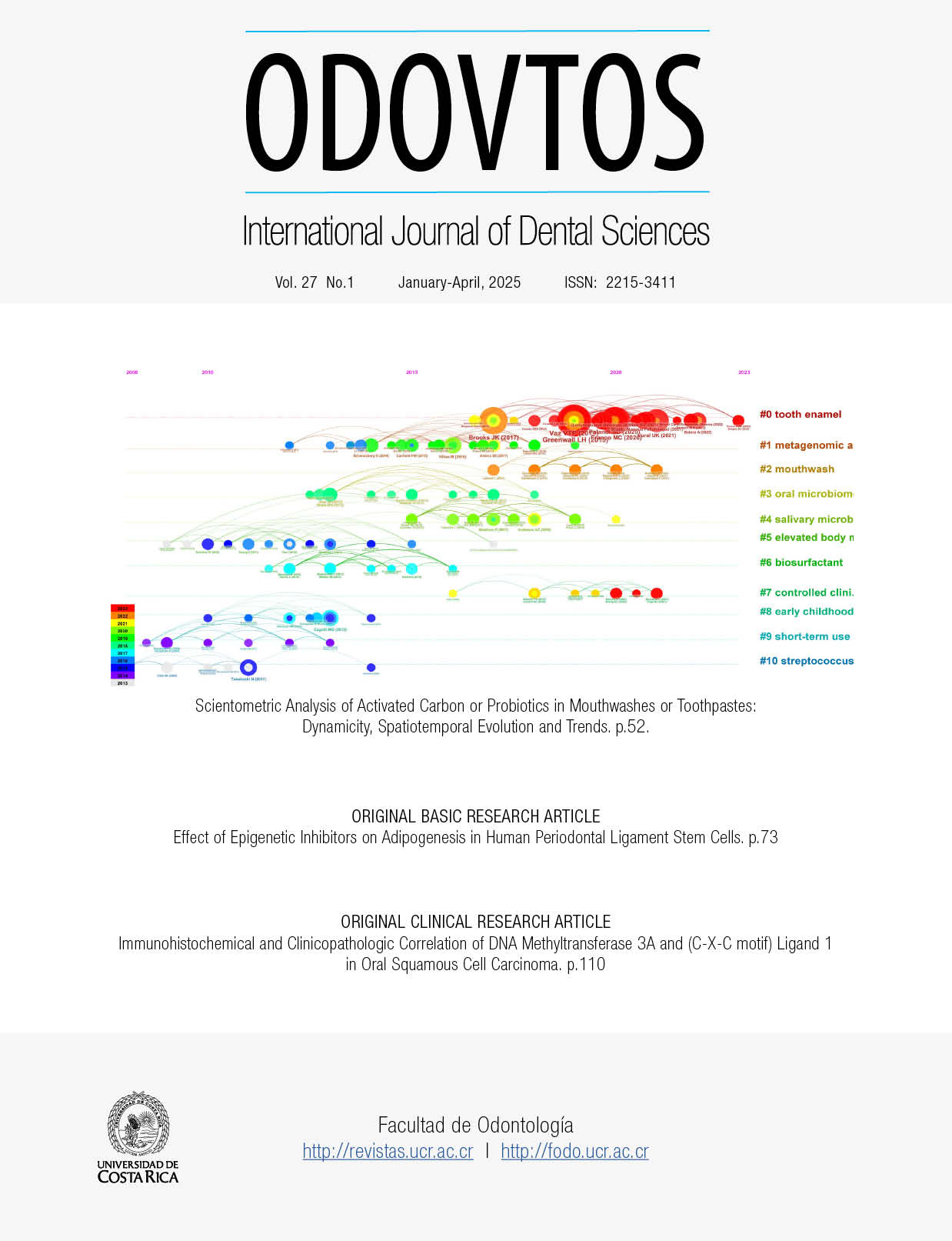Abstract
The aim of this integrative review is to investigate the possibility of aligning three-dimensional intraoral scanner data with facial mobile device data, as well as comparing the effectiveness of AI-based search with manual search methods. This investigation adhered to the PRISMA guidelines aiming to answer the PICO question: “Does the facial and intraoral three-dimensional technologies are compatible and clinically applicable in oral rehabilitation?”. Was employed a search strategy incorporating specific keywords ("dental", "intraoral", "photogrammetry", "stereo photo", "scanner", "three-dimensional", "stereophotogrammetry", "scan", "virtual articulators", "facebow", "face", "facial") within multiple databases (Pubmed, BVS, and Scielo), including artificial intelligence (Scite.ai). Of the 7128 initially identified articles, 4 articles of manual search were included but none article of the artificial intelligence website were added. Among the most used: at the intraoral scanners were the TRIOS (3shape) (n=2) and for facial images the Apple Inc. cell phones (n=2). The most frequently reported software was Bellus3D (Bellus3D Inc.) with particular emphasis on the georeferencing tactic software. Several commonalities were observed, including the requirement for a 30cm spacing during cell phone-based extraoral scanning, the necessity for multiple captures, and the inclusion of landmarks and/or perioral and nasal scans. Manual searching is still the gold standard scientific searching data; Both stereophotogrammetry and mobile device scan can be used for facial scanning and the files can be integrated by utilizing georeferencing tactic software.
References
Khurshid Z. Digital Dentistry: Transformation of Oral Health and Dental Education with Technology. Eur J Dent 2023; 17: 943-4
Perez-Giugovaz M.G., Park S.H., Revilla-Leon M. Three-dimensional virtual representation by superimposing facial and intraoral digital scans with an additively manufactured intraoral scan body. J Prosthet Dent 2020; 126: 459
Kordaß B., Gärtner C., Söhnel A., Bisler A., Voß G., Bockholt U., Seipel S., et al. The virtual articulator in dentistry: concept and development. Dent Clin 2002; 46 (3): 493-506
de Caxias F.P., Dos Santos D.M., Bannwart L.C., de Moraes Melo Neto C.L., Goiato M.C. Classification, history, and future prospects of maxillofacial prosthesis. Int J Dent 2019; 1: 8657619
Ye H., Ye J., Wang S., Wang Z., Geng J., Wang Y., Zhou Y. Comparison of the accuracy (trueness and precision) of virtual dentofacial patients digitized by three different methods based on 3D facial and dental images. J Prosthet Dent 2022; 3913 (22): 99-3. https://doi.org/10.1016/j.prosdent.2022.01.035
Mangano F., Mangano C., Margiani B., Admakin O. Combining Intraoral and Face Scans for the Design and Fabrication of Computer-Assisted Design/Computer-Assisted Manufacturing (CAD/CAM) Polyether-Ether-Ketone (PEEK) Implant-Supported Bars for Maxillary Overdentures. Scanning 2019; 2019: 1-14. https://doi.org/10.1155/2019/4274715
Alshadidi A.A.F., Alshahrani A.A., Aldosari L.I.N., Chaturvedi S., Saini R.S., Hassan S.A.B., et al. Investigation on the application of artificial intelligence in prosthodontics. Appl Sci 2023; 13 (8): 5004
Page M.J., McKenzie J.E., Bossuyt P.M., Boutron I., Hoffmann T.C., Mulrow C.D., et al. The PRISMA 2020 statement: An updated guideline for reporting systematic reviews. J Clin Epidemiol 2021; 134: 178-89
Mai H., Lee D.H. The Effect of Perioral Scan and Artificial Skin Markers on the Accuracy of Virtual Dentofacial Integration: Stereophotogrammetry Versus Smartphone Three-Dimensional Face-Scanning. Int J Environ Res Public Health 2021; 18 (1):229. https://doi.org/10.3390/ijerph18010229
Li J., Att W., Chen Z., Lepidi L., Wang H.L., Joda T. Prosthetic articulator-based implant rehabilitation virtual patient: A technique bridging implant surgery and reconstructive dentistry. J Prosthet Dent 2023; 130 (1): 8-13
Jreige C.S., Kimura R.N., Segundo Â.R.T.C., Coachman C., Sesma N. Esthetic treatment planning with digital animation of the smile dynamics: A technique to create a 4-dimensional virtual patient. J Prosthet Dent 2022; 128 (2): 130-8
Hong S.J., Noh K. Setting the sagittal condylar inclination on a virtual articulator by using a facial and intraoral scan of the protrusive interocclusal position: A dental technique. J Prosthet Dent 2021; 125 (3): 392-5.
Sun A., Yang Y., Gao H., Lin W.S., Chen L., Tan J. Integrating facial and intraoral scans for digital esthetic and occlusal design: a technical report. J Prosthet Dent 2021; 30 (8): 729-33.
Conejo J., Dayo A.F., Syed A.Z., Mupparapu M. The digital clone: intraoral scanning, face scans and cone beam computed tomography integration for diagnosis and treatment planning. Dental Clinics 2021; 65 (3): 529-53. https://doi.org/10.1016/j.cden.2021.02.011
Bechtold T.E., Goz T.G., Schaupp E., Koss B., Godt A., Reinert S., Berneburg M. Integration of a maxillary model into facial surface stereophotogrammetry. J Orofac Orthop 2012; 73 (2): 126-37.
Gallardo Y.N., Salazar-Gamarra R., Bohner L., De Oliveira J.I., Dib L.L., Sesma N. Evaluation of the 3D error of 2 face-scanning systems: An in vitro analysis. J Prosthet Dent 2023; 129 (4): 630-636
Ritschl L.M., Wolff K.D., Erben P., Grill F.D. Simultaneous, radiation-free registration of the dentoalveolar position and the face by combining 3D photography with a portable scanner and impression-taking. Head Face Med 2019; 15 (1): 1-9
Andrews J., Alwafi A., Bichu Y.M., Pliska B.T., Mostafa N., Zou B. Validation of three-dimensional facial imaging captured with smartphone-based photogrammetry application in comparison to stereophotogrammetry system. Heliyon 2023; 9 (5). https://doi.org/10.1016/j.heliyon.2023.e15834
##plugins.facebook.comentarios##

This work is licensed under a Creative Commons Attribution-NonCommercial-ShareAlike 4.0 International License.
Copyright (c) 2024 Juliana Lujan Brunetto, Manuel Martin Adriazola Ique, Clovis Lamartine de Moraes Melo Neto, Victor Perinazzo Sachi, Daniela Micheline dos Santos, Marcelo Coelho Goiato


